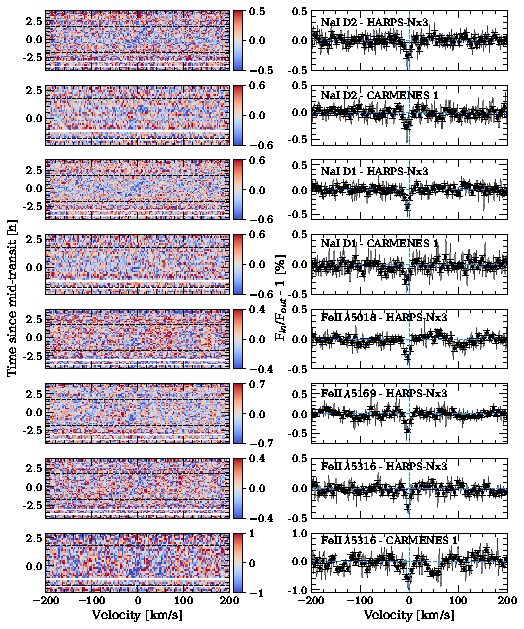Atmospheric characterisation of the ultra hot Jupiter MASCARA-2b/KELT-20b combining HARPS-N and CARMENES observations
The atmospheric absorption features of Ha and Na I were tentatively observed in the atmosphere of MASCARA-2b/KELT-20b (Casasayas-Barris et al. 2018) using one primary transit observation with HARPS-N. Now, by collecting more transit observations with HARPS-N and CARMENES, it has been possible to perform a full analysis of the atmospheric composition of this planet in the optical range. We have elected the presence of different species such as Ha, Hb, CaII, FeII, and NaI in its atmosphere. The absorption signals of Hb and MgI are also observed, although the signal-to-noise ratio is small.
MASCARA-2b was discovered in 2018 by two different teams (Lund et al. 2017 and Talens et al. 2018) and it is a member of a new group of exoplanets, the ultra hot Jupiters, the hottest planets known to date. These particular planets present temperatures higher than 2000K because they orbit very close to their host star, receiving a large amount of irradiation in their day-side upper atmosphere. At these temperatures, some metals are expected to be singly ionised and more abundant than their neutral forms, as it was also observed in Hoeijmakers et al. (2018) with an even hotter planet, KELT-9b.
We observed MASCARA-2b during four transits using high resolution facilities: three using the HARPS-N spectrograph mounted at the TNG and one using CARMENES, mounted at the 3.5m telescope in CAHA Observatory. These two instruments cover slightly different wavelength regions, allowing us to study a wider spectral range, from around 380nm to 960 nm. We have been able, for example, to detect Hb, FeII and MgI only in HARPS-N data, while the CaII triplet has been detected only in CARMENES data, because HARPS-N does not cover that region. On the other hand, for Ha and NaI, both instruments cover those regions, and we have been able to obtain compatible results.
Exploring exoplanetary atmospheres with high resolution spectroscopic facilities has become a state-of-the-art research field. At high resolution, we are not only able to resolve single lines from the exoplanet atmosphere but also characterise these lines with atmospheric models, obtaining important parameters such as the temperature where these lines are formed and other properties of the dynamics of the atmosphere. Thus, 3.5m class telescopes have demonstrated to be powerful tools to study the atmospheres of exoplanets with bright hosts.

|

|
The figure shows the absorption signals observed during the transits of MASCARA-2b/KELT-20b. The 2D maps are shown in the first and third columns (hereafter from left to right) and their derived transmission spectra are shown in the second and fourth columns. The specie and instrument at which the 2D map corresponds is detailed inside its derived transmission spectrum (located in the right side of each 2D map). We note that HARPS-N results come from the combination of the three nights observed with this instrument, while CARMENES results are obtained with only one transit observation. For almost all species shown here it is possible to observe a absorption trail during the transit in the 2D map, with the radial- velocity slope expected for this planet. The color bar corresponds to the relative flux in %.
More information at the paper https://arxiv.org/abs/1905.12491

